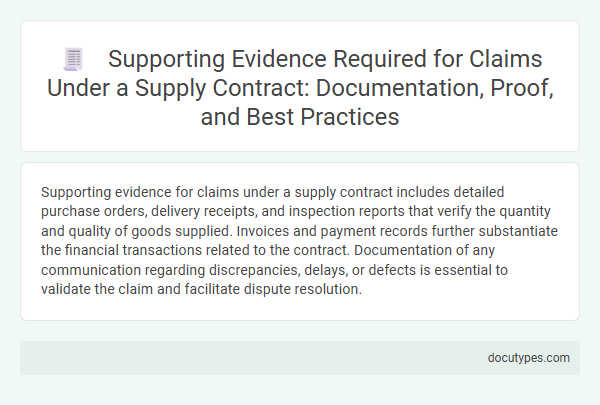Supporting evidence for claims under a supply contract includes detailed purchase orders, delivery receipts, and inspection reports that verify the quantity and quality of goods supplied. Invoices and payment records further substantiate the financial transactions related to the contract. Documentation of any communication regarding discrepancies, delays, or defects is essential to validate the claim and facilitate dispute resolution.
Introduction to Evidence Requirements in Supply Contracts
Understanding the evidence requirements for claims under a supply contract is crucial for a successful resolution. Proper documentation and proof support your position when disputes arise or claims are submitted.
- Contract Documentation - Clearly defined terms and conditions provide the baseline for evaluating claims and verifying compliance.
- Delivery Records - Proof of shipment, receipt, and delivery timelines substantiate performance and fulfillment claims.
- Communication Logs - Emails, letters, and notices between parties help establish timelines and agreements regarding contract modifications or disputes.
Key Types of Claims in Supply Agreements
Claims under a supply contract require specific supporting evidence to validate contractual obligations and resolve disputes efficiently. Understanding key types of claims helps streamline the documentation and verification process.
- Delivery Delay Claims - Proof includes delivery schedules, delay notifications, and correspondence outlining the reasons for delays.
- Quality or Defect Claims - Supporting evidence consists of inspection reports, test results, and non-conformance notices demonstrating product deficiencies.
- Payment and Pricing Claims - Documentation such as invoices, payment records, and contract pricing terms are essential to verify financial discrepancies.
Essential Documentation for Proving Claims
| Type of Evidence | Description | Relevance |
|---|---|---|
| Contract Agreement | Signed copy of the supply contract outlining terms, conditions, and obligations of each party. | Serves as the primary reference point for verifying claim legitimacy and contract scope. |
| Purchase Orders | Documents detailing quantities, specifications, and delivery schedules agreed upon. | Demonstrates what was originally requested, supporting claims related to delivery or specification discrepancies. |
| Delivery Receipts and Shipping Documents | Records confirming delivery dates, quantities received, and condition upon arrival. | Essential for proving on-time delivery or identifying delays and damages affecting your claims. |
| Invoices and Payment Records | Financial documents showing amounts billed, payments made, and outstanding balances. | Helps to validate claims involving payment disputes or financial adjustments under the contract. |
| Inspection and Quality Reports | Results from product inspections or quality control tests relevant to supplied goods. | Supports claims regarding defective or non-conforming products under supply terms. |
| Correspondence and Communication Logs | Emails, letters, and messages exchanged between contract parties discussing terms or issues. | Provides context and evidence regarding acknowledgments, modifications, or dispute negotiations. |
| Force Majeure Documentation | Proof of unforeseen events (natural disasters, strikes) affecting contract performance. | Validates claims for delays or non-performance caused by uncontrollable circumstances. |
Importance of Maintaining Accurate Records
Supporting evidence for claims under a supply contract primarily includes purchase orders, delivery receipts, and correspondence documenting any discrepancies or issues. Maintaining accurate records ensures you can substantiate your claims promptly and avoid disputes. Clear documentation of quantities, specifications, and timelines strengthens your position in contract enforcement.
Proof of Delivery and Acceptance
Proof of delivery is essential to validate the physical transfer of goods under a supply contract. It typically includes signed delivery receipts, shipping documents, or courier records confirming the date and condition of items delivered.
Acceptance evidence demonstrates that the buyer has inspected and approved the goods as meeting contract specifications. This may involve signed acceptance certificates, inspection reports, or email confirmations verifying satisfactory receipt and compliance with agreed standards.
Invoices, Receipts, and Payment Records
Invoices serve as crucial supporting evidence in supply contract claims by detailing the products or services provided, quantities, prices, and payment terms. Accurate and itemized invoices establish the basis for verifying the legitimacy and scope of the claim.
Receipts complement invoices by confirming that payments were made, reflecting the transaction date and amount received. Maintaining organized payment records helps reconcile disputes and validates compliance with contractual payment obligations.
Quality Assurance Reports and Compliance Certificates
Claims under a supply contract require thorough supporting evidence to validate the quality and compliance of delivered goods. Quality assurance reports and compliance certificates play a crucial role in substantiating your claims effectively.
- Quality Assurance Reports - Document detailed inspections and testing results that demonstrate the product meets specified standards.
- Compliance Certificates - Provide official validation that goods conform to regulatory and contractual requirements.
- Traceability Records - Link products to manufacturing batches and quality checks, supporting claim authenticity.
Presenting comprehensive quality assurance reports alongside compliance certificates strengthens the validity of claims under a supply contract.
Communication Records: Emails, Notices, and Correspondence
Communication records such as emails, notices, and correspondence serve as crucial supporting evidence in claims under a supply contract. These documents provide clear proof of agreements, amendments, and notifications between parties involved in the contract.
Emails offer time-stamped written confirmation of discussions, approvals, and requests. Notices formally document important contract events like breaches or delays. Maintaining organized correspondence ensures you can substantiate claims accurately and resolve disputes efficiently.
Best Practices for Organizing and Retaining Evidence
Supporting evidence for claims under a supply contract typically includes purchase orders, delivery receipts, and correspondence documenting any discrepancies or delays. Best practices for organizing this evidence involve maintaining a centralized digital repository with clear labeling and date-stamping of all documents related to each claim. Retaining evidence securely for the duration of the contract and any applicable warranty or dispute resolution periods ensures timely access and strengthens the validity of claims.
What Supporting Evidence Is Needed for Claims Under a Supply Contract? Infographic

